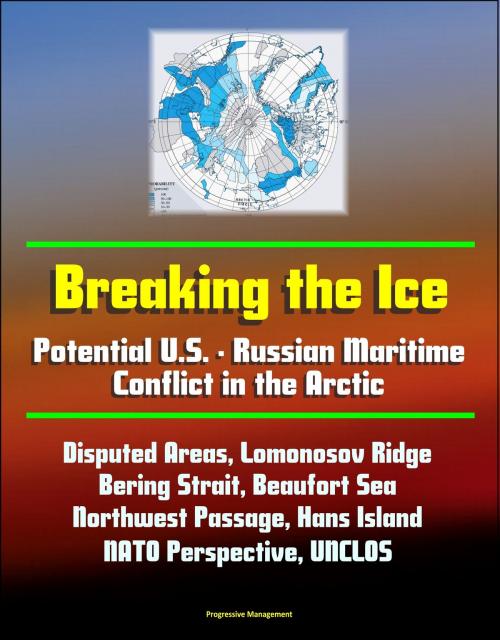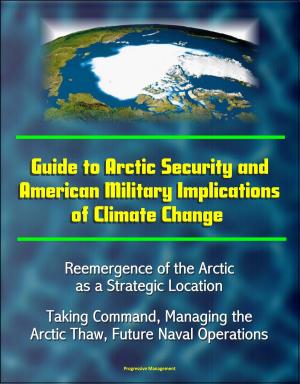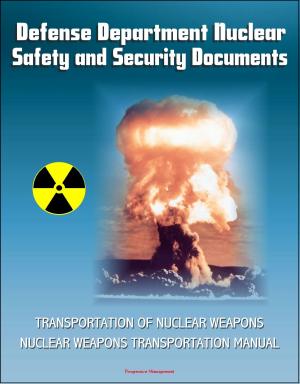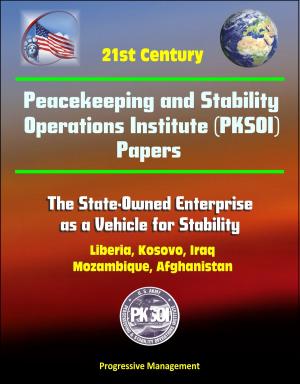Breaking the Ice: Potential U.S. - Russian Maritime Conflict in the Arctic - Disputed Areas, Lomonosov Ridge, Bering Strait, Beaufort Sea, Northwest Passage, Hans Island, NATO Perspective, UNCLOS
Nonfiction, History, Polar Regions, Military, United States| Author: | Progressive Management | ISBN: | 9781310879364 |
| Publisher: | Progressive Management | Publication: | November 27, 2014 |
| Imprint: | Smashwords Edition | Language: | English |
| Author: | Progressive Management |
| ISBN: | 9781310879364 |
| Publisher: | Progressive Management |
| Publication: | November 27, 2014 |
| Imprint: | Smashwords Edition |
| Language: | English |
While war in the Arctic appears unlikely at present, this thesis analyzes why an escalation of territorial and resource disputes in the Arctic up to and including the use of force cannot and should not be ruled out. This thesis examines the political, economic, and military interests of the main Arctic powers—Canada, Denmark, Norway, Russia, and the United States—to set the scene for an assessment of the factors that could make for cooperation or conflict. Advocates of a "Pax Arctica" involving regional cooperation underrate the more pragmatic and competitive factors underlying international relations and the actual limits of international institutions and economic interdependence in restraining behavior in an anarchic system. The potential for U.S.-Russian maritime conflict in the region is genuine. Based on the methodology established for this analysis, it can be reasonably assessed that conflict in the Arctic is likely. No time horizon can be determined, however, because much depends on decisions made (or not made) by these same Arctic powers in the coming decades.
Subject Terms - Arctic, Conflict, Economic Interdependence, International Institutionalism, Threat, Economic Warfare, Navy, Coast Guard, United States, Russia, Canada, Denmark, Norway, China, Japan, United Nations Convention on the Law of the Sea, UNCLOS, Commission on the Limits of the Continental Shelf, CLCS, NATO, NATO-Russia Council, NRC, Arctic Council, Hydrocarbon, Oil, Gas, Arms Race
CHAPTER I * INTRODUCTION * A. MAJOR RESEARCH QUESTION * B. IMPORTANCE * C. PROBLEMS AND HYPOTHESES * D. LITERATURE REVIEW * E. METHODOLOGY AND SOURCES * CHAPTER II * IDENTIFYING THE THREAT * A. WHY NOW? * B. OPPORTUNITY * 1. Staking Claims * 2. Disputed Areas * a. The Lomonosov Ridge — Canada, Denmark, and Russia * b. The Bering Strait — Russia and the United States * c. The Beaufort Sea Canada and the United States * d. The Northwest Passage Canada and the United States * e. Hans Island Canada and Denmark * 3. Summary * C. CAPABILITY * 1. Arctic Orders of Battle and Comparative Capabilities Analysis * 2. Projected Capability Needs Assessment * 3. Summary * D. INTENT * 1. Indications of Threat and Use of Force * a. The United States v. Russia * b. Russia v. Japan * c. Japan v. China * d. China v. Vietnam, the Philippines, Malaysia, and Brunei * 2. Indications of Intent to Use Force * a. Russia's Motivation * b. The NATO Perspective * 3. Summary * E. CONCLUSION * CHAPTER III * MITIGATING FACTORS? * A. CONFLICT RESOLUTION MECHANISMS AND FORA * 1. The UNCLOS * a. Background * b. Peaceful Dispute Resolution Mechanisms * c. Limitations of the UNCLOS * 2. NATO-Russia Council * a. Background * b. Peaceful Dispute Resolution Mechanisms * c. Limitations of the NRC * 3. The Arctic Council * a. Background * b. Peaceful Dispute Resolution Mechanisms * c. Limitations of the Arctic Council * 4. Summary * B. ECONOMIC INTERDEPENDENCE * 1. Potential for a Capitalist Peace? * 2. Past Precedent as a Deterrence for FDI and Interdependence * 3. A Case Study: The Sino-Japanese East China Sea Dispute * 4. Summary * D. CONCLUSION * CHAPTER IV * CONCLUSION * A. SUMMARY OF THE THREAT * B. ANALYZING THE EQUATION * 1. Degree of Economic Dependence on Hydrocarbon Resources in the Arctic (and Elsewhere) * 2. Value of Contested Claims * 3. Ability to Defend Claims * 4. Historical Propensity for Militarized Conflict * 5. Role of International Institutions * 6. Degree of Economic Interdependence * C. CONFLICT IN THE ARCTIC * 1. Potential for Maritime Conflict in the Arctic * 2. Why the United States Should Care: Recommendations for Policy and Action * 3. When Will the Ice Break?
While war in the Arctic appears unlikely at present, this thesis analyzes why an escalation of territorial and resource disputes in the Arctic up to and including the use of force cannot and should not be ruled out. This thesis examines the political, economic, and military interests of the main Arctic powers—Canada, Denmark, Norway, Russia, and the United States—to set the scene for an assessment of the factors that could make for cooperation or conflict. Advocates of a "Pax Arctica" involving regional cooperation underrate the more pragmatic and competitive factors underlying international relations and the actual limits of international institutions and economic interdependence in restraining behavior in an anarchic system. The potential for U.S.-Russian maritime conflict in the region is genuine. Based on the methodology established for this analysis, it can be reasonably assessed that conflict in the Arctic is likely. No time horizon can be determined, however, because much depends on decisions made (or not made) by these same Arctic powers in the coming decades.
Subject Terms - Arctic, Conflict, Economic Interdependence, International Institutionalism, Threat, Economic Warfare, Navy, Coast Guard, United States, Russia, Canada, Denmark, Norway, China, Japan, United Nations Convention on the Law of the Sea, UNCLOS, Commission on the Limits of the Continental Shelf, CLCS, NATO, NATO-Russia Council, NRC, Arctic Council, Hydrocarbon, Oil, Gas, Arms Race
CHAPTER I * INTRODUCTION * A. MAJOR RESEARCH QUESTION * B. IMPORTANCE * C. PROBLEMS AND HYPOTHESES * D. LITERATURE REVIEW * E. METHODOLOGY AND SOURCES * CHAPTER II * IDENTIFYING THE THREAT * A. WHY NOW? * B. OPPORTUNITY * 1. Staking Claims * 2. Disputed Areas * a. The Lomonosov Ridge — Canada, Denmark, and Russia * b. The Bering Strait — Russia and the United States * c. The Beaufort Sea Canada and the United States * d. The Northwest Passage Canada and the United States * e. Hans Island Canada and Denmark * 3. Summary * C. CAPABILITY * 1. Arctic Orders of Battle and Comparative Capabilities Analysis * 2. Projected Capability Needs Assessment * 3. Summary * D. INTENT * 1. Indications of Threat and Use of Force * a. The United States v. Russia * b. Russia v. Japan * c. Japan v. China * d. China v. Vietnam, the Philippines, Malaysia, and Brunei * 2. Indications of Intent to Use Force * a. Russia's Motivation * b. The NATO Perspective * 3. Summary * E. CONCLUSION * CHAPTER III * MITIGATING FACTORS? * A. CONFLICT RESOLUTION MECHANISMS AND FORA * 1. The UNCLOS * a. Background * b. Peaceful Dispute Resolution Mechanisms * c. Limitations of the UNCLOS * 2. NATO-Russia Council * a. Background * b. Peaceful Dispute Resolution Mechanisms * c. Limitations of the NRC * 3. The Arctic Council * a. Background * b. Peaceful Dispute Resolution Mechanisms * c. Limitations of the Arctic Council * 4. Summary * B. ECONOMIC INTERDEPENDENCE * 1. Potential for a Capitalist Peace? * 2. Past Precedent as a Deterrence for FDI and Interdependence * 3. A Case Study: The Sino-Japanese East China Sea Dispute * 4. Summary * D. CONCLUSION * CHAPTER IV * CONCLUSION * A. SUMMARY OF THE THREAT * B. ANALYZING THE EQUATION * 1. Degree of Economic Dependence on Hydrocarbon Resources in the Arctic (and Elsewhere) * 2. Value of Contested Claims * 3. Ability to Defend Claims * 4. Historical Propensity for Militarized Conflict * 5. Role of International Institutions * 6. Degree of Economic Interdependence * C. CONFLICT IN THE ARCTIC * 1. Potential for Maritime Conflict in the Arctic * 2. Why the United States Should Care: Recommendations for Policy and Action * 3. When Will the Ice Break?















